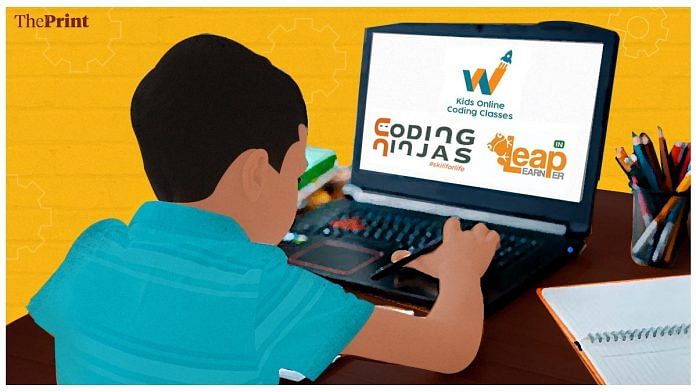New Delhi: Aileen Walia loves studying about stars and planets. These days, the 7-year-old, who studies at the Tagore International School in the national capital, is taking her interest to the next level, developing astronomy apps and games in her coding classes.
Walia is among hundreds of young children in the country who have taken to ‘coding’ lessons in the last few months — the latest education fad that has grown especially since the lockdown amid online studies.
Coding, in simple terms, is the language that computers use to understand and process human commands.
In the last few months, more and more parents in India have enrolled their children in coding classes. While some have done it to keep their kids up to date with competition, others simply want to make their children learn something new.
Walia’s father Daman Pal Singh said he enrolled Aileen because he wanted her to “learn something new, something that she can enjoy right now and use it in the future”.
“I am glad that she is enjoying learning coding — she is developing apps, games and her mind is opening up to new ideas. She is learning how to find solutions to problems, how to think out of the box, whether she wants to become a software developer or coder in future is up to her, but she will definitely have an edge,” he said.
Anupama Venkatraman, whose 10-year-old daughter has been learning coding for the last few months, said she is teaching her daughter coding because “I feel that technology and artificial intelligence is the future and children should be abreast with the subjects”.
“Her school is not very technology-focused in their teaching, hence I enrolled her with LeapLearner where she takes one class a week. I am happy to see the progress that she has made… She is much better in handling gadgets, taking her notes and understanding problems and finding their solutions,” said Venkatraman.
Also read: Delhi govt to frame policy for regulating private coaching centres
Why coding
Schools don’t offer coding as a subject as part of the curriculum. So, parents are opting for private online players like White Hat Jr, Coding Ninjas and LeapLearner, among others.
These platforms say coding is as essential as mathematics, physics and chemistry, and is here to stay.
“When kids learn coding they learn computational thinking and algorithmic intelligence. It basically means that children are learning how to solve a problem… They learn to break down the problem in sub-problems and solve them. Coding is, however, not the only way they learn computational thinking, they learn that through chess as well,” said Rahul Ranjan, chief executive officer, LeapLearner.
Asked why so many children are learning coding suddenly, Ranjan said, “Nothing has changed suddenly. Older kids have been learning coding at school level for some time now, but with everything around us becoming more technology-driven, parents are learning the importance of teaching coding to kids at an early age.”
The platforms also said that coding is for everyone, whether or not children want to be coders and software developers when they opt for a career.
“We do not want to make kids software developers. We want kids to develop the ability to think and find solutions to a problem. It helps them in thinking clearly and when they pass on instructions to a computer they are very specific,” said Ankush Singla, co-founder Coding Ninjas and Coding Ninjas Junior.
“Coding actually moves kids from how to use something to how to build something, they start asking questions — how an app was built, how a game was built and want to learn to make their own,” he said.
However, the coding that young children are learning is very different from what professionals are taught.
Explaining the difference, Siddharth Maheshwari, co-founder of Newton School, a start-up that teaches coding to college students, said, “For kids at a small age, coding is all about having fun, igniting the curiosity… They build games and apps in subjects that they are interested in, whereas, a software developer needs to learn about what works in the market.”
Also read: High cut-off doesn’t matter, ‘nearly half of DU seats’ already filled day before second list
Is coding for everyone?
Coding lessons come at a hefty price for parents, who have to shell out anywhere between Rs 4,500-6,000 for 12 group classes, and between Rs 7,000 and Rs 10,000 for 12 individual classes depending on the platform they chose to enroll their kids with.
Typically, classes last for an hour or an hour-and-a-half, and are scheduled once or twice a week.
While the subject is gaining popularity among kids whose parents can afford it, those from the underprivileged families don’t have the means for it. Due to this, some educators have started to teach coding to empower students from the low-income section.
For instance, 30-year-old Irfan Lalani runs a non-profit in Ahmedabad, Code to Enhance Learning, which has so far taught coding to over 3,000 kids in the 10-15 age group.
“Through coding I want to teach children a language relevant to this century which can help them build technology based solutions to problems they see around them in their community,” he said.
Lalani believes the theoretical manner in which computers and technology is taught to poor children needs a tectonic shift. He said the subject should be taught as a means to have positive physical outcomes.
He cited examples of his students’ work to highlight the work that’s needed. “Have you seen a grade five student code a monopoly-like game called ‘Foodopoly’ to learn about United Nations Sustainable Development Goals (SDG) on Zero Hunger? Or maybe an application called ‘Walk to Feed’ to encourage people to walk to feed hungry people for SDG Good Health and Wellbeing?”
With inputs from Soniya Agrawal.
Also read: Cabinet approves STARS project under NEP 2020 to enhance school education system






